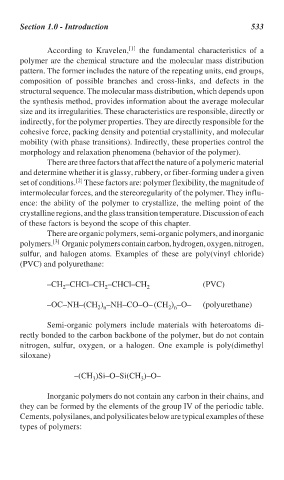Page 563 - Handbook of Thermal Analysis of Construction Materials
P. 563
Section 1.0 - Introduction 533
[1]
According to Kravelen, the fundamental characteristics of a
polymer are the chemical structure and the molecular mass distribution
pattern. The former includes the nature of the repeating units, end groups,
composition of possible branches and cross-links, and defects in the
structural sequence. The molecular mass distribution, which depends upon
the synthesis method, provides information about the average molecular
size and its irregularities. These characteristics are responsible, directly or
indirectly, for the polymer properties. They are directly responsible for the
cohesive force, packing density and potential crystallinity, and molecular
mobility (with phase transitions). Indirectly, these properties control the
morphology and relaxation phenomena (behavior of the polymer).
There are three factors that affect the nature of a polymeric material
and determine whether it is glassy, rubbery, or fiber-forming under a given
[2]
set of conditions. These factors are: polymer flexibility, the magnitude of
intermolecular forces, and the stereoregularity of the polymer. They influ-
ence: the ability of the polymer to crystallize, the melting point of the
crystalline regions, and the glass transition temperature. Discussion of each
of these factors is beyond the scope of this chapter.
There are organic polymers, semi-organic polymers, and inorganic
[3]
polymers. Organic polymers contain carbon, hydrogen, oxygen, nitrogen,
sulfur, and halogen atoms. Examples of these are poly(vinyl chloride)
(PVC) and polyurethane:
–CH –CHCl–CH –CHCl–CH 2 (PVC)
2
2
–OC–NH–(CH ) –NH–CO–O– (CH ) –O– (polyurethane)
2 n
2 n
Semi-organic polymers include materials with heteroatoms di-
rectly bonded to the carbon backbone of the polymer, but do not contain
nitrogen, sulfur, oxygen, or a halogen. One example is poly(dimethyl
siloxane)
–(CH )Si–O–Si(CH )–O–
3
3
Inorganic polymers do not contain any carbon in their chains, and
they can be formed by the elements of the group IV of the periodic table.
Cements, polysilanes, and polysilicates below are typical examples of these
types of polymers:

